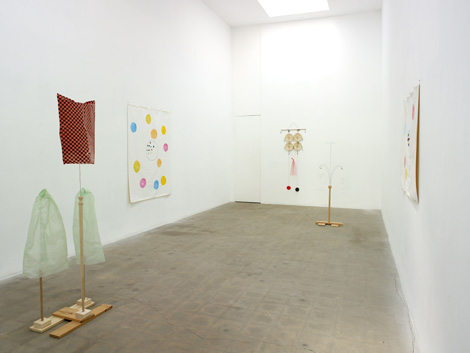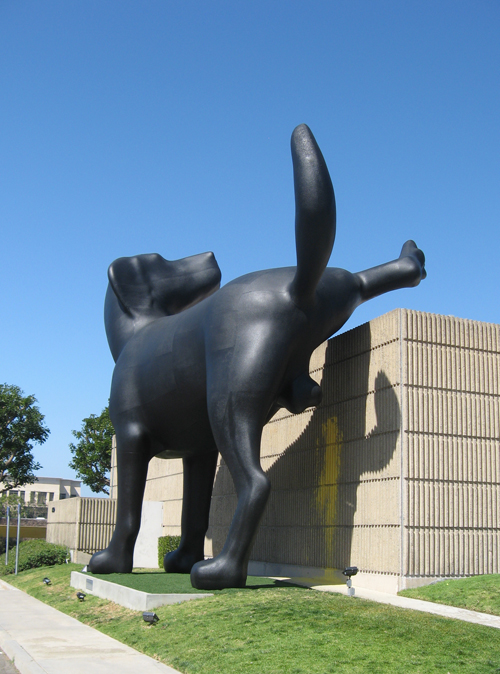Your cart is currently empty!
Tag: representational sculpture
-

B. Wurtz
Even more than, say, Richard Tuttle, to whom he might (uneasily) be compared—B. Wurtz tests a viewer’s relationship to objects and construction of their meaning, significance, even utility. This encompasses relations among objects, and by extension, our relationship with the world.
The sculptures in this show (all Untitled, 2014), no different from most of his others, are quintessential ‘mysterious’ or enigmatic objects—a mix of constructions of crafted or hand-finished basic and art materials, found objects, and standard manufactured hardware. (I will never look at an eye-hook in quite the same way.) These objects are refashioned or manipulated—all very precisely configured and utterly transformed in their new arrangements.
In using the most mundane, ordinary materials, including what amount to discards and detritus (plastic bags, plastic containers, lids and similar packaging), as well as buttons, fixings and fastenings, Wurtz reveals a kind of physical and symbolic grammar of objects and materials that is as simple or complex, reductive or expansive, as the materials and their configuration entail. In its funky formalism, a de facto, non-doctrinaire quality, it offers a kind of rebuke to Minimalism.
The “off-hand” has never looked more precise.
Consider a bust-height configuration of four undulating wires, each suspending a white or (primary) colored button surrounding a single vertical wire, which extends six inches above and is surmounted by a veil of a folded red-white plaid napkin, all embedded on a short wooden dowel itself standing on a small square plywood base. (A jockey and chariot? Italian restaurant kitchen goddess?)

B. Wurtz, Untitled, 2014. Photo by Marten Elder, Courtesy of Richard Telles Fine Art. To view these sculptures in conjunction with Wurtz’s works on paper is to test our relationships with objects in representations—maps, pictures, diagrams. Wurtz subtly tests the alteration and transformation of these relationships in such works and hanging pieces that usually lay more or less flat against the wall. Not far from the untitled red-checked napkin ‘figure,’ Wurtz showed a suite of grommet ‘constellations’ triangulated by three painted ‘buttons’ (actually large painted dots circling grommets). The buttons’ primary colors are offset by a single secondary (frequently green) in an inverted chevron configuration. A single primary plastic cap ‘button’ is suspended by a thread from the triangle’s apex and extends just below the paper’s edge.
Although there were more paper or hanging pieces than free-standing sculptures in this show, the sculptures largely determined the conversation among the objects, if for no other reason than the fact they impinged on the viewer’s physical space. This was magnified by the addition of random appropriated design elements—e.g., in one piece, the red-and-black checkerboard pattern of a plastic bag rising above two more standard pale-green grocery store plastic bags. There is some emphasis here to respective positioning, shapes and volumes (inflation and deflation), of larger and smaller bags. The darks and lights of the cruciform-stepped wood base make their own discrete statement. In a blog post, I called this piece a ‘red-and-black mass’; and what we might call a ‘Westermann’ aspect is evident in both the sculptures and some of the hangings. But the purity and precision of Wurtz’s abstractions are entirely his own.
-

Richard Jackson
Richard Jackson is a maniac with paint. His current retrospective is a testament to the gargantuan ambitions and massive amounts of energy he has displayed over a 40-plus-year career. The exhibition’s title, “Ain’t Painting a Pain,” is indicative of his commitment to the act of painting, although his real achievement as an artist is how he has consistently pushed the boundaries of the painting medium into installation, performance and sculpture, while still retaining a focus upon the act of painting itself.
A Jackson installation from 1980, “Big Ideas—1000 Pictures,” made an unforgettable impact when exhibited at Rosamund Felsen Gallery in Los Angeles with its 1000 painted canvases stacked from floor to ceiling. The radical nature of “the idea” as a way of dealing with painting was unprecedented—it could conceivably be compared to Pollock’s breakthrough drip paintings in its inventive re-thinking of the painting medium. The multi-colored, process-laden pattern, like bricks and mortar, was visually compelling as well. These works were intentionally ephemeral, but the OCMA show features a new similar work, “5050 Stacked Paintings” (2013), a monumental stack of dripping canvases creating a structure akin to terraces. One of the most formally captivating works in the show displays Jackson’s relation to both minimalist and process vocabularies.
The exhibition features work from every period of Jackson’s career, including several wall works from the period 1969–1988 made by pushing heavily paint-coated canvases across gallery walls, another terrific innovation of the painting process. Also included are many of the perspective drawings he has done over the years to plan his projects. In their visual resonance, the drawings are outstanding as works of art themselves and provide an intimate view into the playful musings that eventually resulted in huge projects requiring vast amounts of labor and materials.
“1000 Clocks” (1987-92), which was shown in “Helter Skelter” at MOCA in 1992, seems to mark the mid-point in Jackson’s career. The work he has done since then has been a departure, at least stylistically, from the painting installations of the 1970s and 80s. Jackson’s installations from the last two decades continue the exuberant energy of his earlier, more abstract projects, but the recent work is characterized by the use of representational sculptural forms. Much of his imagery is culled from art historical sources, as well as those reflecting more of a Pop, or Postmodern sensibility.
This work, while impressive, sometimes struggles to transcend spectacle—Bad Dog (2013), a giant dog peeing yellow paint on the museum is a hilarious jab at stuffy institutions, but lacks the complexity and innovation of the painting installations inside. However, “The Blue Room” (2011) is amongst the most successful of the newer installations. Based upon imagery from both Picasso and Duchamp, the painted installation pulsates with an inimitable chromatic energy.
What remains consistent throughout all the work is a love of the substance of paint itself—a highly-saturated, dripping, runny, viscous material. Jackson’s oeuvre wryly deconstructs art’s most enduring and dominant tradition.


